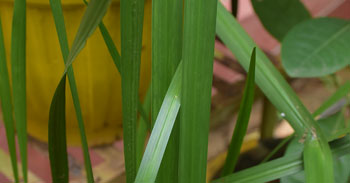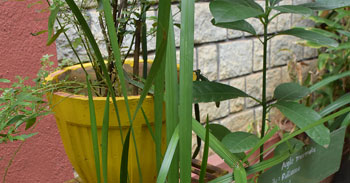KJC Medicinal Garden
Baje
Acorus calamus
Order: Acorales
Family: Acoraceae
Genus: Acorus
Species: A.calamus
Common Names: Sweet flag ,Sway or Muskrat root
Native to Throughout Asia ( from India to Japan) , Phillipines and from Indonesia to Siberia
Other plants of the same genus with medicinal properties
-
A.gramineus
A.americanus
- Herbaceous perennial ( 2m tall)
- Leaves: erect yellowish-brown colour, radical with pink sheathing at the base and have parallel veins and basal arrangement
- Stems are solid and unbranded
- They have cylindrical ,branched ,knobby rhizome.
- Flowers: green- brown or yellow ,spike inflorescence.
- Fruit - tiny capsule which is inverted pyramid shaped ,containing 2 or 3 seeds. Fruits dry to become brown .
Uses in Tradition systems of medicine
- Used in Ayurveda
- Leaves, stem, flower, root, are used for the treatment for fevers, stomach cramps
- Their rhizomes were used for toothache and powdered rhizome for congestion.
- The rhizome part is also used to treat diseases like asthma and bronchitis and as sedative.
- Also used for gastrointestinal problems
- Helps effectively in skin diseases
- Vitamin - Ascorbic acid, beta carotene and tocopherol
- Carbohydrates-37.26%
- Crude lipid -0.00057%
- Total energy value estimated to 121.65Kcal /100g
- Total free amino acid content - 25.71 µg/500mg.
Suggested Medicinal Properties
- Antibacterial
- Antifungal
- Anti-inflammatory
- Antidiabetic
- Hypolipidemic
- Antioxidative
- Anti-cancer
Active Phytochemicals
1. Active Phytochemicals
2. Monoterpenes: A number of monoterpenes has been reported in the plant. Few of the monoterpenes reported are myrcene, Para-cymene, α-terpinen, β-phellandrene,Terpinolene, Thujane and Limonene .
3. Xanthone glycoside ( 4, 5, 8-trimethoxyxanthone-2-O-β-D-glucopyranosyl (1-2)-O-β-D-galactopyranoside )
4. Lignans
5. Flavones (5, 7-dihydroxyflavonol)
6. Triterpenoid saponin
7. Essential oil- α-asarone,(E)-methylisoeugenol,methyleugenol ,β-asarone,α-cedrene and camphor.
8. Glycosides, carbohydrates, phenolic compounds, alkaloids, flavonoids and tannins, saponins, steroids and triterpenoids are major phytochemical groups.
9. Steroids ( β-Sitosterol )

References
Deepak Chandra and Kundan Prasad ,"Phytochemicals of Acorus calamus" - Journal of Medicinal plant studies -2017;5(5):277-281.
Manju Soman1, Pratap Chandran Ramachandran Nair1*, Vysakhi Manappurathu Vinod1, Shaji Pavithran Kesavamongalam2, Achuthan Nair - "Nutritional and Anti-nutritional status of Acorus calamus" - Annals. Food Science and Technology 2014 .

